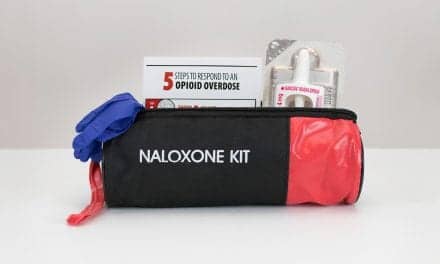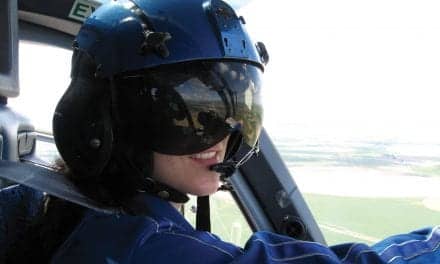Transporting patients during medical emergencies can impose risks that Respiratory Therapists are well equipped to manage.
By Rich Smith
Hundreds of times daily, air transport teams across the nation ferry life-threatened patients from accident scenes or from small, underequipped hospitals to major medical centers where the critical care they need awaits. Typically, those flight teams consist of a nurse and an EMT—the EMT increasingly turns out also to be a respiratory therapist.
That is because the contribution of respiratory therapists to the successful transport of trauma patients and the gravely ill is more and more recognized as invaluable—so much so, in fact, that a handful of air-ambulance programs now require a respiratory care practitioner aboard every such trip, even when the patient’s respiratory functioning is not at issue.
“The patients we transport are generally the sickest of the sick and will have been under the care of a registered nurse and an RT when we pick them up at a hospital, so, that being the case, we decided we would simply continue that very effective provider mix on our flights,” says Jerry Focht, RRT, NREMT, CMTE, chief flight respiratory therapist for Northwest MedStar in Spokane, Wash.
Patrick Dowd, RRT, NPS, EMT, flight respiratory therapist with LIFE-STAR, a Hartford, Conn-based transport service funded by Hartford Hospital, explains that the RT-RN pairing is a smart move because of the respiratory risks likely to be encountered.
“There’s a lot that can go wrong with a patient’s respiratory or cardiovascular status during transport,” he says. “RTs are well trained to deal with those problems.”
At both Northwest MedStar and LIFE-STAR, the transport vehicle used most often is a helicopter. Northwest MedStar owns four of them; LIFE-STAR, two.
Viewed from the outside, a helicopter appears large and roomy. On the inside, though, there is not much more space than you would find in your average family minivan—and that is before the equipment is loaded in.
“Our helicopters are crammed with enough gear and supplies to allow them to function as miniature emergency rooms in the sky,” says Dowd.
Typically carried aboard is a pulse oximeter and other types of monitors, a defibrillator, an external pacemaker, a noninvasive blood-pressure machine, a ventilator, IV pumps, a suction unit, warm fluids, oxygen, and as many as 40 or more medicines. There also are a variety of rescue and surgical airways.
“Our intubation devices may be the most important,” Dowd contends. “When a patient is in emergent need of an airway, everything else becomes secondary. You can give a patient any kind of medication you want or defibrillate them all day long, but it’s game over if they’re not getting air.”
Dowd says standard operating procedure requires making sure before takeoff that the patient’s airway is open. Occasionally, an RT is forced to intubate on the go—a task not easily accomplished owing to the bumpiness of flight and, worse, the lack of room for maneuvering.
“I haven’t yet had to intubate during a flight,” says Dowd.
Dowd is a relative newcomer to flight transport, having joined LIFE-STAR in mid 2003. He is along for the ride on 15 to 20 flights a month out of the 1,200 the organization logs each year. Dowd started as a hospital-based respiratory therapist 9 years ago. His first employer was the University of Massachusetts in Worcester, a major trauma center where he was able to obtain adult, pediatric, and neonatal experience. Before being tapped by LIFE-STAR, he worked at busy Massachusetts General Hospital in Boston. A friend already flying with LIFE-STAR urged him to apply for a position at the transport service. It sounded challenging and fun, but Dowd said he needed time to mull over the opportunity.
“I didn’t want to rush into anything, because it’s a major commitment to do this kind of work,” he says. “Air transport isn’t your typical 9-to-5 job. It’s not even your typical 7-to-7 hospital job.”
Eventually, Dowd decided to go for it.
“I realized it fit right in with the aggressive career goals I’d set for myself,” he says, explaining those included employment in settings where he could be held to the most demanding standards possible. “I also liked the idea of being in a role where my daily contributions would be helping push the envelope on the scope of respiratory care.
“On top of all that, I didn’t want at the end of my career to look back with regret. I didn’t want to look back and say to myself, ‘Gee, flying around in a helicopter—that’s the kind of thing I wished I could have done when I was young.’”
State of Readiness
Like Dowd, the RTs at Northwest MedStar work 12-hour shifts. Among the first tasks they perform when they arrive at the hangar is a run-through of readiness checklists. There is one such checklist for each MedStar aircraft (in addition to its quartet of Eurocopter EC-135 twin-engine jet-prop helicopters, the organization operates a pair of King Air 200 twin-engine fixed-wing planes).
“The checklist focuses on the equipment and supplies inside the aircraft,” says Focht. “This drill ensures we don’t depart only to discover midway that we forgot to replace some critical item or medication used up the last time out.”
Another start-of-workday task finds the RTs and RNs gathering for a briefing, similar to that which takes place in a hospital at the beginning of a shift change.
RTs assigned to a transport team are not always on the go. They can expect at times to face long hours of inactivity between calls.
“It’s the same as being in a fire station,” says Focht, who assures that the lulls are never idled away. “RTs occupy themselves by checking equipment and supplies, engaging in continuing education opportunities, and rehearsing transport techniques—for instance, they practice on a computerized human-patient simulator we recently purchased that allows us to perform a half-dozen difficult airway maneuvers, including chest darts and IV tubes.”
Only about 15% of the runs made by MedStar involve airlifting a patient from the scene of an accident. The remainder are trips in which a patient is moved from one hospital to another. Calls for those inter-facility flights usually come without advance notification.
“We don’t often get to schedule these things,” says Focht. “A hospital calls us because they’ve got a patient who has suddenly taken a turn for the worse and needs right away to be taken to a distant facility that has, for instance, a cath lab or higher-level trauma care.”
Once the request for an immediate flight comes in and the chopper goes aloft, the RT and the RN discuss the case and decide the actions they will need to take after the patient boards.
“A lot of times, the strategy you work out on the way to the pickup has to be completely changed when you get there because you find out the patient’s parameters are different from what you were originally told to expect,” he says.
Flying High
The helicopter lands, the hatch pops open. The RT and RN hurry into the hospital building where they are greeted by awaiting staff. The duo are handed a status report on the patient. They give it a quick read, then initiate their own assessments of the patient, led off by a check of vital signs. Next, they perform a changeover of drip lines.
“If the patient is also on ventilator support, the RT will get the aircraft’s portable unit ready,” says Focht. “He or she will check end-tidal CO2 and then program our ventilator to mimic the one the patient has been on at the hospital.”
The patient is transferred to a gurney and wheeled out to the helicopter, then strapped into the rotorcraft’s floor-mounted bed. Onboard monitors are turned on to provide constant information about the patient—especially important with patients at risk of fibrillation, Focht says.
Back in the air, the RT and RN perform the tasks necessary to keep the patient stable or to obtain improvement. The ride to the destination hospital could take anywhere from 10 minutes to an hour, depending on distances involved and weather conditions encountered, Focht offers.
“We’ve had a few 4- and 5-hour flights,” Focht says. “If we’re going to be in the air that long, we have to carefully calculate the amount of oxygen to bring aboard with us for the patient who’s on a vent.”
The EC-135 helicopters—with a cruising speed of 130 knots—can travel 260 nautical miles on a full tank of gas (which happens to be 182 gallons). They operate under visual flight rules, so if it is foggy out, the choppers do not fly. They are also grounded on days when winds hit sustained speeds of 50 knots or greater. Further, they are barred from landing on rooftops if the wind is greater than 35 knots. On those dangerously windy days, Northwest MedStar uses instead its King Air 200 airplanes, which can fly far higher than the helicopters, way up where the air is relatively calm.
“The drawback to using fixed-wing is that it increases by two the number of times you have to transfer the patient,” says Focht. “Fixed wing can take off and land only at an airport. So you have to load the patient into a ground ambulance and then drive out to the airport; then load him or her into an ambulance again at the airport when you land. The extra transfers can be hard on the patient in critical condition, so it’s one of the factors we have to weigh in deciding whether we can go by air at all or if we have to take the trip entirely by ground.”
(Northwest MedStar has a contractual arrangement with an ambulance company to supply surface vehicles. Recently, however, the organization went shopping for a pair of ambulances to call its own.)
Roles of Engagement
Aboard air ambulances, the RTs and RNs have different duties, but on the flights conducted by LIFE-STAR, each knows how to perform the other’s job in the event of an emergency.
“Our goal,” says Dowd, “is to have the two people who form the clinical team on each flight trained and fully qualified to complement one another so that, if one is having difficulty performing a certain task because attention must be focused on another aspect of the patient’s care, the second member of the team can step right in and competently assist.”
Moreover, the two clinical members of every LIFE-STAR team are dual credentialed, with all of the nurses and half the RTs holding paramedic licenses (the other half of the RT contingent bear EMT certificates).
“You can only be considered for a position with LIFE-STAR if you are dual credentialed,” says Dowd.
That likely will be the case into the foreseeable future, although 5 years from now the role of the RT in air transport could be appreciably different from that of today.
“Frankly, I’d hope to see RTs involved more broadly in the care of these patients,” Focht says. “Right now, our respiratory therapists train the same way as do the nurses, but chart only on respiratory-related issues. We’re not as involved in the total patient picture as I think we can be.”
Dowd is inclined to agree, but asserts that any headway made by RTs on that front will depend on how the turf battles are fought and won in the various transport programs around the country. Nurses, he implies, would need to be willing to cede ground in the air and allow RTs to assume a greater role.
Says Focht, “I don’t know about elsewhere, but in my organization we have a very supportive group of nurses. They’ve been very accepting of the RTs, who’ve really worked hard over the years to prove themselves in this role.”
The ability of RTs to cross over into roles now held by RNs aboard ship may be limited not by nursing’s resistance but by barriers erected in state legislatures. Nonetheless, the range of tasks that RTs in Connecticut and other states can legally perform when engaged in patient transport is already impressively lengthy.
Impressive is the word to describe as well the value RTs bring to the daunting and risk-fraught work of transporting. Says Dowd, “We’re proud of what we do, and of what we’re able to accomplish.”
For these respiratory therapists, the sky truly is the limit.
RT
Rich Smith is a contributing writer for RT.










